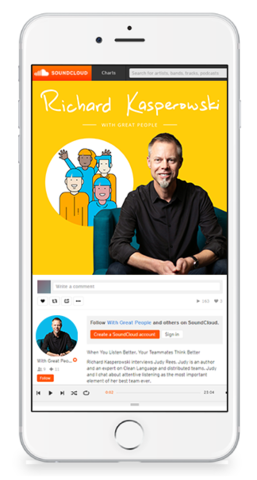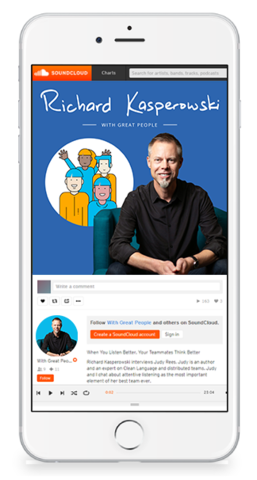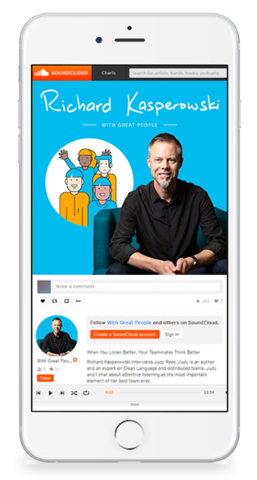Categories
Catherine Louis: How to Make Your Current Team Your Best Team
In this episode, Richard interviews Catherine Louis. Catherine is a coach, trainer, and consultant helping people like their customers, create high-performance teams, optimize value, innovate and learn together. But it is Catherine’s unique experience as a K9 handler and a search and rescue technician that brings valuable new perspectives on rapid deployment, dynamic teams, and quick team cohesion.
When you finish listening to this episode, connect with Catherine on Twitter and LinkedIn.
Watch video
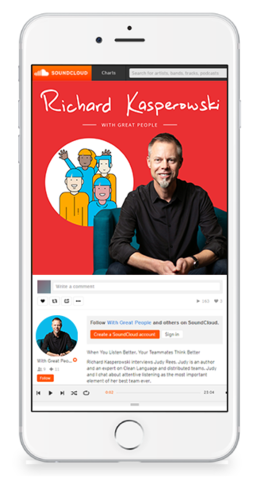
Listen Audio
Catherine Louis: How to Make Your Current Team Your Best Team
with Catherine Louis
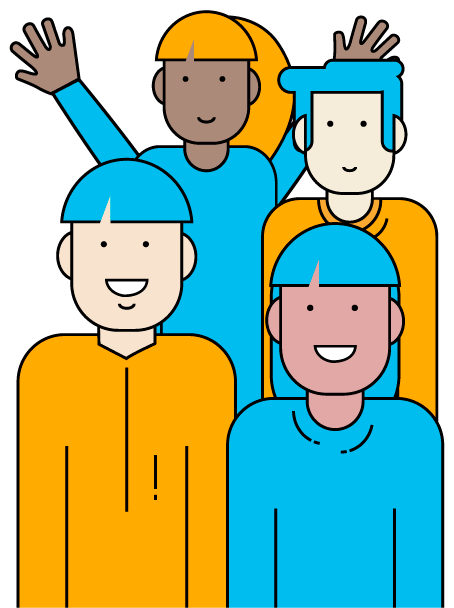
TRANSCRIPT
Richard:
Hi friends, welcome back to With Great People. The podcast for high performance teams, I’m Richard Kasperowski, and our special guest today is Catherine Lewis. Catherine is someone who knows a lot about a lot of different kinds of teams, she’s a coach, trainer and consultant. She helps people delight their customers, create high performance teams, optimize value, innovate, and learn together. To support this podcast, visit my website, Kasperowski.com.
Richard:
Hello, Catherine. It’s so great to see you again.
Catherine:
Hey Richard, thanks for inviting me.
Richard:
Oh my pleasure. I’ve been looking forward to this for a long time. We’ve been trying to set a date and one or the other of us has been busy and I’m so happy we can finally do this. Is there anything else you would add on to that introduction? What else would we about you?
Catherine:
I really enjoy helping teams solve wicked problems. And perhaps one thing folks don’t know about me is I’m a canine handle handler, a search and rescue technician, I help find missing people using my little doggy right there that’s Vega and we get called out by emergency management in North Carolina. So it’s a something I’ve been doing over 20 years.
Richard:
Cool, cool. And it’s interesting and unusual. It’s not for most of us, it’s not a normal thing we think about or talk about or of course do so it’s really cool.
Catherine:
Yeah, I don’t have a picture here, but I have one in the kitchen of my grandmother who used to import German shepherds and train them for the Chicago Police Department. And I was the one year old baby that they put in the tree for those dogs to learn and find. So I’ve kind of been handed down this work with animals to find missing people thing.
Richard:
Wow, so this has been in your family for generations.
Catherine:
Little bit, yeah.
Richard:
That’s so cool. So this podcast is about teams and you work with a lot of teams. You do a lot of interesting things with a lot of different kinds of teams. What’s your single best team ever? Work team, a search and rescue team, any kind of team at all, any group of two or more people who have a common goal, what’s your best one of those?
Catherine:
I’m going to answer this from what I’ve learned with Search and Rescue and what I’ve learned in my tech career. And I’ve been in tech since I was 17. The best team ever is the team that I have at the moment.
Richard:
Okay. And okay, I need you to expand on that. What do you mean, the best team is a team you have in the moment?
Catherine:
I think there’s a tendency for folks to look outside of their team, to find somebody else to improve the team before looking at what the team, where the team wants to go themselves and how can we help them as a team together, help each other grow. And if we focus there, you’ll get the best team.
Richard:
Okay. Now I want to make this concrete, is there a team of the moment right now, or a recent team of the moment that we could talk about.
Catherine:
The last search I went on, that could be the last search I went on, I got a brand new team. Don’t know these people, meet the team, figure out what skills we have, how can we help each other, what our mission is, how we’re going to run the mission, how we collaborate in this mission and how we find the person.
Richard:
Yeah. Yeah, there’s so much there. I’ve got a lot I want to say. And I’m sort of at the same time, like stunned and shocked that it it’s hard to get the words out. It’s like an instantaneous team. It’s a spontaneous team. Heidi Helthen would call it a dynamic team. You, you always have a new team, They’re the short lived, they have a very specific mission and purpose.
Catherine:
Yeah, and search over search, you see some of these same people again and get to go out with them again. But you know, there’s a lot that we have in common. You know, we have the bug, we want to find that missing person. So we’re all out there. We believe in it, we believe in the mission.
Richard:
Yeah.
Catherine:
So imagine a team that you’re on and a tech team, and you start out just assuming everybody believes in the mission, isn’t really a good thing to do.
Richard:
Or that we even know what the mission is.
Catherine:
Yeah, we could perhaps just work and not know why we’re working.
Richard:
Yeah, I mean, I just love writing code. Just loves walking in the woods, I don’t know.
Catherine:
Yeah.
Richard:
But it would really good to get that out, right? And, and so you have, I don’t know, some techniques, do you have like a checklist you go through to spin up, to connect together as a team quickly.
Catherine:
You are probably familiar with this market of skills exercise we do with agile teams. It’s a great one to do with the team. You know you say, hey, what skills do we have to offer one another? I’ve got pets at home, for example, I could help you watch your dog. They ask, what does your dog do when they find sent? And I explain to them, now I have a flaker, you know, somebody who can help me watch my dog or somebody else says, you know, I’ve been in Orient Hearing Club for 20 years. Okay, you’re our navigator, you know? So you have, what are the skills people have? And then you do another round of that and say, what’s maybe one skill that you have under the table that you want to share, that might not be related to search at all. And I used to be, I was in combat and I was a medic, oh, okay. There’s somebody who can help us if somebody gets hurt. And then you ask, what do you want to learn from one another? And you get this collaboration. Yeah. Also check for what’s in everybody’s backpack. We share what’s in our backpack. Do you have enough water? If you don’t have enough water, get the water that you need so that we can go out for 12 hours. What do you need that you don’t have, that somebody else could supply? You know, so you’re instantly cover for one another, even before you start.
Richard:
All right. So that’s a great way to put up a team really fast and connect with each other. And actually, I usually admit this, when I say this is what a team is, I define the word team, but you’re actually figuring out how to depend on each other, right. ‘Cause that’s what a team really is. When you can’t do it without each other. So you’re really connecting with that.
Catherine:
Yeah, yeah. I mean, I have asthma. I want to make sure everybody knows where my inhaler is because you know, I might not be able to reach it when I need it, you know? So you show your own vulnerabilities too.
Richard:
Oh that too. Yeah, I’m taking little notes as we go. So this most recent search and rescue team, another thing I always ask is if you could take the experience of being on that team and the way it felt to be there, the way it felt within you, what’s one word you could use to describe the feeling of being together with that team.
Catherine:
Two words, fluidly, collaborative.
Richard:
Fluidly collaborative, and what do you mean?
Catherine:
So we’re collaborating and not just, you know, two people collaborating, the whole team is collaborating and it’s not planned. It’s fluid.
Richard:
Yeah, what’s an example of that?
Catherine:
We have an area and I have somebody near me who’s helping me watch my dog. And then somebody on the other end notices that we are actually in the middle of an Angus beef ranging area. And these are not nice animals. So everybody, let’s head and we give them a coordinate that’s on the other side of a fence, so it’s something that we can handle, you know? Yeah. I don’t know if that’s a good example, but it’s what it feels like. You know, it’s a complex thing search. There’s the environment. There’s the animal that has good days and bad days, the search dog, people have good days and bad days, the weather conditions, because the scent is on the wind and this complexity is just like software development complexity.
Richard:
Okay, that’s interesting. And okay, so there’s a lot of complexity, including with the search dog. And you told me something that I joke about with my wife sometimes when we’re walking our little dog who is not a search and rescue dog, she’s just a little, you know, little dog. But even sometimes she does this, you told me something like training a search and rescue dog. Basically what you’re teaching the dog and I’m going to mangle what you told me. But the way I say is, when you’re training a search dog, you’re teaching the dog that there are these slow animals who can’t hear well, who can’t smell well, who can’t see well, they walk on two feet instead of four feet and you just have to be patient with a humans, dear search dog. And even our little house dog is like this with us sometimes, she’s like looking back at us, like why can’t you keep up?
Catherine:
Yeah.
Richard:
Or why didn’t you hear that? Why can’t you smell this? Why aren’t you fascinated by this scent on the ground?
Catherine:
They get to communicate very elaborately. I mean, sometimes she’ll smell like the sock of the missing person, and do you see it? Do you see it, and then jump on me? Like there it is. Do you get it, do you get it again? And again, because I’m the dumb one at the end of the leash.
Richard:
Right, it’s a funny way to think about dogs and humans. Funny way to think about humans. We’re the dumb ones at the end of the leash.
Catherine:
We are.
Richard:
This most recent search and rescue team subjectively, how do you know that it was a great team?
Catherine:
I kind of alluded to it earlier. We really care about what we’re doing. And there’s a feeling of giving and receiving trust. We operate like a team, so if somebody is in need of help, we slow down and help the slowest person on the team because we’re only as fast as the slowest person on the team. And we all want to get better at what we’re doing. So we want feedback. We all want feedback all the time.
Richard:
All right, there’s a couple things in there I want to hear more about, this idea about as a team, we’re only as fast as the slowest person on the team. Is that generalized to all teams? Is it specifically or only for search and rescue teams?
Catherine:
So let’s take it to a tech team where some director says that for every five developers, we need one tester. How fast do you think that team is going to be able to go?
Richard:
That team is going to be as fast as that one tester, I mean, if they care about product quality.
Catherine:
Yeah, exactly, yeah. So it’s the same thing. There’s multiple skills on the team and we experiment to try to do, so normally there’s one handler per dog, and I’ve been playing with this idea of, so let’s say you’re on the team. You’re searching further away. And then I send my dog to you to search with you a little bit and then come back to me. So I’ve expanded my coverage area with the dog helping between. And then when I come back to incident command, I show them the map that has the dog trail, your trail and my trail. And we can eliminate that search area it’s covered.
Richard:
Yeah. Got it, and what about, you mentioned feedback, all of you want feedback, what is that about?
Catherine:
Let’s just take last weekend’s training. I have my partner’s dog I was working ’cause he has a broken wing. He had rotor cuff surgery and working his dog. I need help with different angles reading his dog, so I don’t work him alone. I make sure I have the missing subject recording on video and then two other people recording on video. And then I take these washers and I put flagging tape on the washers and I give them to everybody. And I say, when you see something, just toss that where you saw it, toss the washer. And then when we finished the problem, we debrief, looking at all the washers and getting the feedback from everybody. What did they see?
Richard:
So interesting.
Catherine:
And I learned so much about reading the dog with that kind of feedback.
Richard:
Okay, okay, what a great technique. I want to do that with people teams.
Catherine:
Yeah, you can, I’ve done it. Here’s what I do with my search team. I’ve pull out the flagging tape with all these washers. Just drop the washer where you need to give some feedback. And then at the very end of whatever activity is, we’ll just look at all the washers and get the feedback.
Richard:
What a cool tool, what a great technique for learning.
Catherine:
Yeah, I like it because you can pull one out of your pocket and throw it towards a wood line where that thing happened. It’s kind of almost necessary in the woods. It would be a little dramatic in the classroom.
Richard:
I’ve used something like that in real work. But it was like only as a joke or only for negative feedback. We had like an NFL yellow flag that we would throw. It was actually, it was actually the TMI flag, the too much information flag. If somebody was like oversharing, which in retrospect, there is no oversharing. That’s like connecting with each other more. But in that team, our norm was if somebody was sharing too much, we would throw the flag.
Catherine:
That’s funny.
Richard:
But if we could have used that for like maybe a green flag or something, or just a neutral flag, anytime something interesting happens, we could have used it.
Catherine:
Yeah, I think it would have to be something that doesn’t make as much noise as a washer.
Richard:
Or as dramatic as an NFL referee flag.
Catherine:
Yeah, yeah.
Richard:
So this idea of the feedback technique with the washers, that’s something, that’s a technique you were doing. That’s a behavior that you were doing and that’s something that somebody from outside the team could have observed. Is there anything else objective about the team that we could use to know that this was a high performing team.
Catherine:
Objective versus subjective. Lots of laughter, lots of laughter. And we have this. So the variables are huge. You know, there’s the search area that has stuff in it that we don’t know what’s in there. ‘Cause it’s a brand new area, the dog, the human, the weather, and plus your own personal emotions at the time on that day. And you want to set up these experiments playing with all of this. So go to Lowe’s Garden Center and put somebody in one of those closed containers and see if your dog can find the person that’s in a place where cushions should be, but make sure they have air. If you’re putting somebody in there, put somebody at some inaccesible places, just think about all the things that could, the Angus beef example, there’s so many things that can happen and you want to be experimenting all the time. So experimentation happens all the time. And because of that, you need to make sure there’s a safe to fail environment because you know these experiments are not going to work. The dog’s going to be afraid of stuff. The human’s going to be afraid of stuff. The wind’s going to be the wrong direction. That’s the same with tech teams. You need to make it safe to fail. Objectively, you hear lots of peer recognition. And I think peer recognition is so much more powerful than recognition from above and so much more appreciated than recognition from a above. And you know, you hear a lot of thanks a lots. That’s great, as well, you get a lot of feedback, so that’s great. Next time, try da, da, da, da. So it’s not taken with a hard, what are you giving feedback for? All of us network outside of the team. So lots of learning, lots of networking with other professionals. And I do that with search, I do that with technology, you know, try to block time to learn. And we mentioned feedback, but if I don’t get feedback, I start getting uncomfortable. So getting itchy and uncomfortable. So those are all objective. I think another one would be when we’re not aligned as a team, it’s obvious, like instantly obvious, but that’s okay, we just stop and address it.
Richard:
How is it obvious?
Catherine:
Real good example, the searchers go like that, you know, we’re actually supposed to be searching this area.
Richard:
Yeah. Literally not aligned, yeah.
Catherine:
Yeah, and I think teams, tech teams should feel the same. You know, what are we building? Are we building two different things? So just take that time to get that alignment back.
Richard:
All right. Is there a concrete behavior for getting that alignment back or what are some of the concrete behaviors for this search and rescue team that make them so great?
Catherine:
Oh, we make sure that experiments are big and visible. You know, here’s my hypothesis. Here’s what I want to try. Here’s where I want folks to be for feedback. And at tech teams, I find the strategizers test card is a really great way to make experimentation big and visible and safe to fail. You know, the test card has what’s the hypothesis, what’s the test, what are we going to measure? We are right if whatever criteria is met and you could just have a backlog of these test cards. So you’re just continually experimenting.
Richard:
Is this strategizers test card something I could find somewhere.
Catherine:
I’ll send it to you, yeah.
Richard:
Okay, I want to want to make sure people listening to us or watching us can get some of this, goodness.
Catherine:
Yeah, is there a way when you post the podcast, you can put the link in it, yeah.
Richard:
Yeah, for sure.
Catherine:
We’ll make sure you have it.
Richard:
Great. So I get how to do that if I’m working with a tech product development team, make it big vis, make these hypotheses, these experiments safe, big, visible, safe to fail. How are you doing that with the search and rescue team? Are you documenting these on paper and like waving the paper around while you’re outside? Or how does it happen?
Catherine:
There’s a GPS collar on the dog. There’s a track on my watch. There’s a GPS colla on team members. And then the washers with the flags, you know, and the debriefing. And then each of us personally have like how we’re writing it up and what’s the next experiment that we want to do.
Richard:
Okay, so you’re pausing, like sort of reconvening with each other, reviewing what happened, getting realigned, setting the next experiment, is it like that?
Catherine:
Yeah, well, each handler would have the track for their experiments for their dog. So we have to do our own work. And then we come back to the team saying, hey, can you help me with the next thing I want to work on?
Richard:
Okay, okay, cool. Cool, and everybody gets aligned and on that same experiment together.
Catherine:
Yeah, yeah. And we try to set up problems so that team members can use the same, having missing people as hard to do. So can we use same problem to run everybody’s experiments ’cause it’s like we’re training for finding missing people.
Richard:
Right. So you need somebody to pose as a missing person while you’re doing this.
Catherine:
Yeah, yeah. I think if we just ran problems and we didn’t see any feedback, it would be pretty much worthless. And in tech teams, you went real feedback, feedback from customers, not just from a stakeholder who wants the button orange, we want the real feedback.
Richard:
I’m like, that was such a weird laugh. But I’m thinking about having customers that would give us feedback that was like, we want that screen to look a little sexier. And we’re like, what are you talking about? How do we do that? We need something more concrete.
Catherine:
Yeah, concrete behaviors. I think another one is that everybody has a voice. You’ve been on teams where like only one person is talking, telling everybody what they have to do, collaboration actually has a healthy buzz and the buzzing has come from all of the team members. This is more than three, but I think another concrete behavior is you can really see that people are taking time for learning, whatever it is, going to a class or going to looking at webinars or presenting at a conference, you can see the time that’s taken out for learning.
Richard:
Yeah, all right, so, okay. People can copy some of these ideas, these concrete behaviors. What else could people do to reproduce the success of a team like this?
Catherine:
I’d say the first thing is talk to your team. What is currently missing that they need? And you know, the daily scrum, do you have any impediments that you have? No, no, no, no. Instead of asking that, say, what’s one thing that you really could have used that would’ve made today better? And somebody might have answer, well, I have really bad headache ’cause my screen is so small. Order bigger screens, you know like, so maybe ask that question differently, instead of do you have an impediment, what’s going to make your day better?
Richard:
That’s such a good way to phrase that, yeah. The impediment is I have a headache, but I don’t think of it as an impediment.
Catherine:
Yeah, and it could be because of your equipment or it could be because of your lighting or whatever. Take the time to really see how you can help and ask the team, are you the one causing them stress? You know, you being there could be, you know, get out of the way if you need to get out of the way. Another thing is I meet so many teams that have just never been given the time to gel as a team. Like I mentioned, when I start with the SAR team, I do this market of skills and we’re vulnerable with one another saying what we want to learn from another.
Richard:
Okay, so there’s a concrete way to be more vulnerable. And this is one of those things. People say be more vulnerable, but we don’t know how to do it. Here’s a way to do it. You tell other people what you want to learn or you know, like, which is a way of saying, it’s a positive way of saying there’s a gap in my skillset and that’s definitely a vulnerability.
Catherine:
Yeah, or I need to be able to search this area and I have asthma. I could have an asthma attack, my asthma thing is here. Does anybody have my back? You know, who can actually help me in this situation? And it opens the door for other people to say, yeah, I have a allergy to bees and my EpiPen is over here. So you really need to know that on a search. So let your team lead where they want to grow and then support them and get out of their way.
Richard:
All right, any other advice for people to have a super successful team like that?
Catherine:
You may find the team that you already have as the best team if you give them space to get there.
Richard:
All right. What a lovely potential episode title.
Catherine:
That’s right.
Richard:
Now, there’s so much stuff going on. You and I, have collaborating on things for a couple of conferences. Is there anything else you want to add? Anything that’s been on your mind, search and rescue is big in your mind, training and coaching teams is big on your mind. Anything else you want to, you want to add on?
Catherine:
Well I would like to plug the conferences that we’ve may be doing Scrum Alliance and Agile Alliance. And it’s on this topic. So if you are interested, we will follow up this podcast with a link to conferences.
Richard:
Hope so.
Catherine:
Me too.
Richard:
Definitely our goal.
Catherine:
Me too.
Richard:
Is there a way for listeners or viewers to get in touch with you?
Catherine:
Yeah, on Twitter @CatherineLewis, all one word or linkedin.com/INCatherineLewis. All one word.
Richard:
Perfect, perfect. Well, gosh, Catherine, thank you so much for the conversation. It’s been so great to reconnect and thank you so much for being here.
Catherine:
Thank you, thank you. You’ve given me more ideas for things we can do at the next conference.
Richard:
Oh good. I can’t wait. And dear listeners and viewers, remember to support this podcast, just visit my website, Kasperowski.com.



